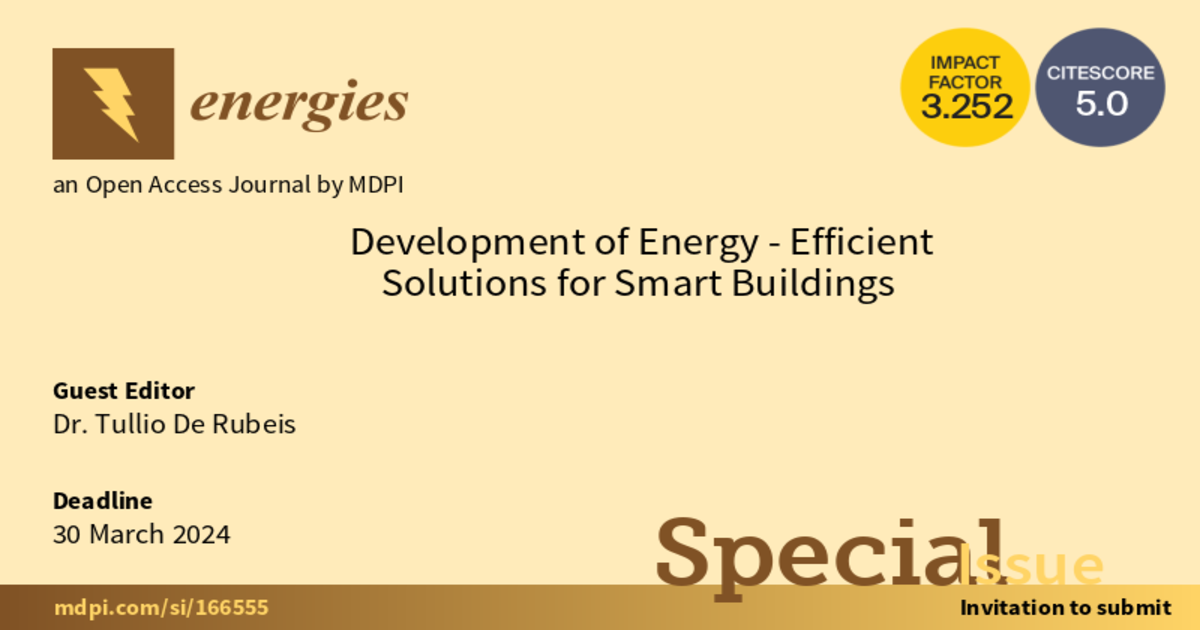Development of Energy-Efficient Solutions for Smart Buildings
A special issue of Energies (ISSN 1996-1073). This special issue belongs to the section "G: Energy and Buildings".
Deadline for manuscript submissions: closed (30 March 2024) | Viewed by 1232

Special Issue Editor
Interests: building physics; energy efficiency; lighting systems; dynamic simulations; lighting control systems; heat transfer; renewable energy
Special Issues, Collections and Topics in MDPI journals
Special Issue Information
Dear Colleagues,
The building sector is one of the main contributors to final energy consumption, with 104.9 exajoules globally [1], and it is still highly dependent on the consumption of oil products and natural gas, resulting in a high production of greenhouse gas emissions.
Thus, in this scenario, it is essential to study innovative and advanced technological solutions that can contain the energy consumption of buildings while ensuring high indoor environmental quality.
This Special Issue on the “Development of Energy-Efficient solutions for Smart Buildings“ aims to collect high-quality scientific papers varying from innovative HVAC and lighting systems solutions to smart and green building proposals.
The Special Issue welcomes papers on the following topics:
- HVAC systems solutions;
- Lighting systems solutions;
- HVAC and lighting control systems;
- Building simulation;
- Smart and green buildings;
- Sustainable and innovative materials;
- Climate change and weather data;
- Renewable energy sources for buildings;
- Thermal and visual comfort;
- Heat transfer in multilayer building components;
- Daylight harvesting;
- Nondestructive testing;
- Smart and innovative HVAC control strategies;
- Urban building energy modeling;
- Machine learning approaches;
- Smart solutions;
- Case studies.
Reference
[1] https://www.iea.org/data-and-statistics/data-tools/energy-statistics-data-browser?country=WORLD&fuel=Energy%20consumption&indicator=TFCShareBySector
Dr. Tullio De Rubeis
Guest Editor
Manuscript Submission Information
Manuscripts should be submitted online at www.mdpi.com by registering and logging in to this website. Once you are registered, click here to go to the submission form. Manuscripts can be submitted until the deadline. All submissions that pass pre-check are peer-reviewed. Accepted papers will be published continuously in the journal (as soon as accepted) and will be listed together on the special issue website. Research articles, review articles as well as short communications are invited. For planned papers, a title and short abstract (about 100 words) can be sent to the Editorial Office for announcement on this website.
Submitted manuscripts should not have been published previously, nor be under consideration for publication elsewhere (except conference proceedings papers). All manuscripts are thoroughly refereed through a single-blind peer-review process. A guide for authors and other relevant information for submission of manuscripts is available on the Instructions for Authors page. Energies is an international peer-reviewed open access semimonthly journal published by MDPI.
Please visit the Instructions for Authors page before submitting a manuscript. The Article Processing Charge (APC) for publication in this open access journal is 2600 CHF (Swiss Francs). Submitted papers should be well formatted and use good English. Authors may use MDPI's English editing service prior to publication or during author revisions.
Keywords
- smart buildings
- energy efficiency
- HVAC and lighting systems
- case studies
- optimization
- comfort
- renewable sources
- sustainable buildings





